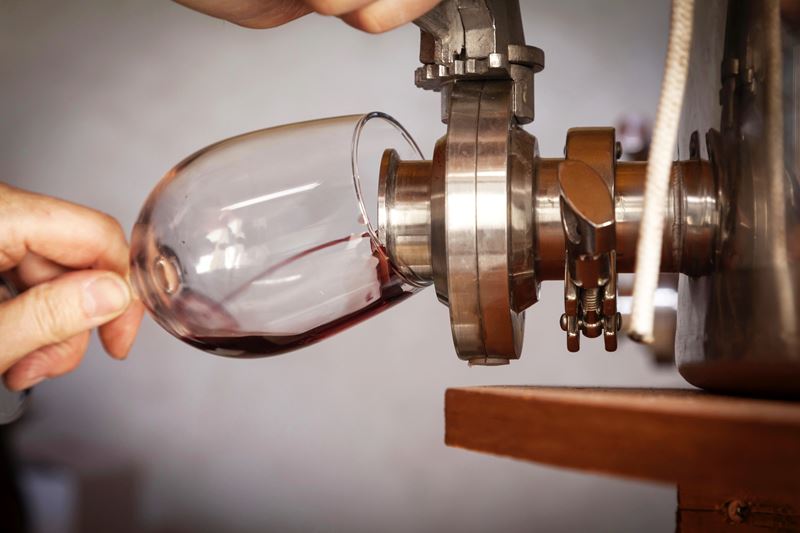Membrane Contactors: The Cutting-Edge Technology Shaping Modern Winemaking
How innovation in gas management is paving the way for the future of winemaking
2024-04-05

In the winemaking world, an innovative shift toward precision and sustainability has begun to reshape the landscape, especially when it comes to managing the intricate dance of gases within the wine itself. Enter the scene: membrane contactors, a game-changer in the industry, bringing about efficiency, precision, and a reduction in the use of auxiliary products. Let's pop the cork and delve into how these systems are revolutionizing wine production and bottling, making every sip better than the last.
The Gas Management Tango in Winemaking
For decades, vintners have known the subtle yet significant role gases play in wine. The right amount of carbon dioxide (CO2) can turn a flat wine vibrant, while oxygen (O2) management is crucial in preventing unwanted oxidation, preserving the wine's integrity through its aging journey. Traditional methods, though rich in heritage, often fell short in achieving the precision required by today's market demands, leading to inefficiencies and inconsistencies in gas concentrations, notably CO2 and nitrogen (N2).
The Rise of Membrane Contactors
Membrane contactors, once primarily championed in the water treatment industry, have found their spotlight in winemaking. These systems offer a level of finesse in gas management that traditional methods can only dream of, allowing simultaneous handling of multiple gases. This is a big deal in an industry where the balance of CO2 and O2 can make or break a vintage. A typical system sees wine flowing through hollow fiber membranes, with gases moving in counter-current, allowing for precise adjustment of gas concentrations within the wine.
The Science Behind
At the heart of this innovation are hollow fiber membrane contactors, characterized by their high packing density and orderly flow pattern. These membranes are so hydrophobic and finely porous that they prevent wine from clogging the system while allowing gases to pass through freely. This setup enables the winemaker to dial in the desired gas levels with pinpoint accuracy, optimizing the wine's quality and longevity.
Why Membrane Contactors?
Membrane contactors offer a bouquet of benefits over traditional gas injection methods. They allow for the simultaneous removal of O2 and adjustment of CO2 levels, sidestep the risk of N2 oversaturation, and meet stringent gas concentration specifications with ease. Moreover, these systems are versatile, finding their place at various stages of the winemaking process, from tank transfers to direct implementation in the bottling line. This adaptability, coupled with high precision, spells out significant savings in time and resources, all while upholding the wine's quality.
Beyond Gases: Alcohol and SO2 Management
But wait, there's more! Membrane contactors aren't just about gases. They're also making waves in alcohol and sulfur dioxide (SO2) management. Climate change has led to grapes with higher sugar (and thus potential alcohol) content, pushing winemakers to seek methods to adjust alcohol levels gently. Membrane contactors step in here, allowing for the reduction of alcohol content without compromising the wine's character. Similarly, they offer a more delicate way to reduce SO2 levels in must, a task traditionally achieved through less gentle means.
Cleaning and Maintenance: A Vital Chapter
The efficiency of membrane contactors depends significantly on cleanliness. The wine industry's unique challenges, such as the risk of microbial growth or flavor and aroma alterations due to wine residue, necessitate meticulous cleaning protocols. Thankfully, the design of these systems and the materials used in the membranes accommodate a wide range of cleaning methods, ensuring the system's longevity and reliability.
Regulatory Notes and Future
As with any innovation in food and beverage production, regulatory approval is key. Membrane contactor technology for gas management in winemaking has gained recognition and approval for use, marking it as not just a novelty but a viable, forward-thinking choice for wineries aiming for quality and sustainability. Yet, it's important to note that certain applications, like alcohol reduction, face regulatory restrictions in some regions.
The adoption of membrane contactors in winemaking is a testament to the industry's ongoing evolution towards precision, efficiency, and sustainability. As wineries worldwide embrace this technology, it's clear that the future of winemaking is not just about preserving tradition but enhancing it, ensuring that every bottle of wine not only tells a story of its origins but also of innovation and care.
Founded in 2007, Vinetur® is a registered trademark of VGSC S.L. with a long history in the wine industry.
VGSC, S.L. with VAT number B70255591 is a spanish company legally registered in the Commercial Register of the city of Santiago de Compostela, with registration number: Bulletin 181, Reference 356049 in Volume 13, Page 107, Section 6, Sheet 45028, Entry 2.
Email: [email protected]
Headquarters and offices located in Vilagarcia de Arousa, Spain.